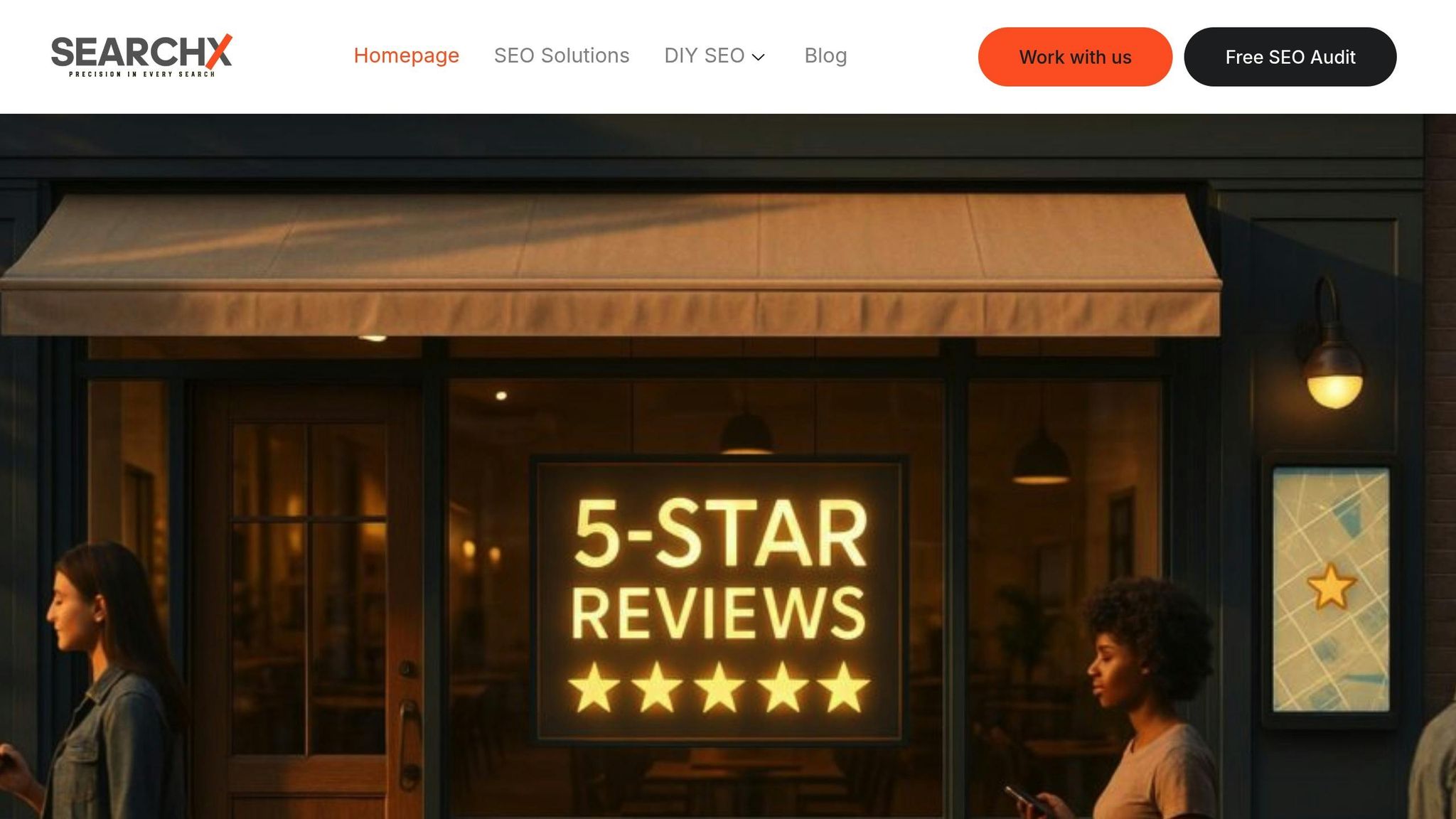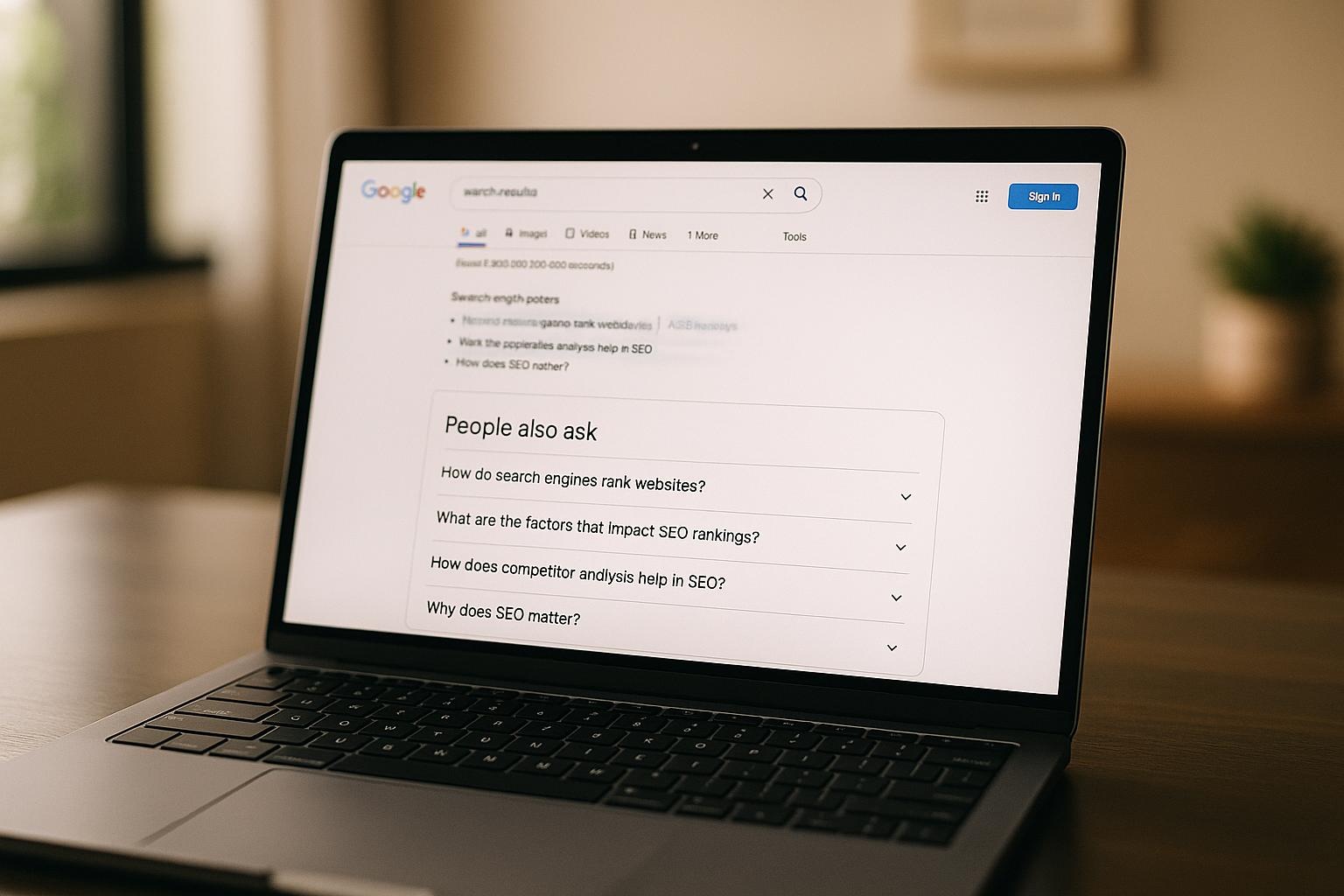Want to rank higher on Google? The "People Also Ask" (PAA) feature can change how your site performs in search results. Here’s the deal:
- PAA boxes appear at the top of Google search results, showing related questions users often ask.
- They can push traditional results down, giving even lower-ranked sites a chance to grab attention.
- If your content gets featured in PAA, it can drive traffic, improve visibility, and position you as a trusted source.
But here’s the challenge: PAA can also reduce clicks to organic results and increase competition for high-value keywords. To succeed, you need to optimize your content for question-based searches, structure answers clearly, and keep your content updated.
This article explains how PAA works, how it affects rankings, and how you can use it to your advantage.
How People Also Ask Changes Competitor Rankings
How PAA Takes Up Search Results Space
The People Also Ask (PAA) feature has reshaped how search result pages are structured, taking up some of the most valuable real estate on the page. Positioned typically between the top 1-3 results, these boxes push down competitors who previously enjoyed prime visibility. This effect is even more pronounced on mobile devices, where screen space is already limited.
What makes PAA boxes stand out is their interactive nature. Unlike static organic results, these boxes expand when clicked, revealing snippets of answers and even generating more related questions. This cascading effect further reduces the visibility of traditional search results, as the expanding layout consumes even more space.
Additionally, PAA boxes are visually striking. With their bold question formatting and expandable sections, they naturally draw users’ attention. Competitors ranking in positions 4-6, for instance, may find their visibility significantly reduced when PAA boxes dominate the upper part of the page. For those featured in PAA, however, the rewards can be substantial, as these boxes often enhance their visibility and traffic.
Benefits of Appearing in PAA Results
Getting featured in PAA results can be a game-changer because it bypasses the constraints of traditional rankings, offering visibility even for pages that rank lower in organic results.
One key advantage is the authority boost. When Google selects your content for a PAA box, it signals to users (and search engines) that your site is a trusted source of information. This often leads to higher click-through rates and improved competitive positioning.
PAA results also encourage longer user engagement. When users interact with PAA questions, they often explore multiple related queries, creating a browsing pattern that keeps them engaged with your content longer. This behavior can translate into increased time on site and deeper exploration of your content, giving you an edge over competitors.
Another major benefit is the traffic distribution. PAA boxes can drive significant traffic to your pages, even if your site struggles to compete in traditional rankings. This is especially helpful for newer websites or those going up against well-established competitors.
Lastly, PAA inclusion opens up keyword expansion opportunities. A single piece of content can appear in PAA boxes for several related questions, multiplying its visibility without requiring additional optimization for each keyword variation. This efficiency makes PAA optimization a valuable strategy for maximizing reach.
Traditional Rankings vs. PAA: A Comparison
Here’s a quick look at how traditional organic rankings differ from PAA results:
| Aspect | Traditional Organic Rankings | PAA Results |
|---|---|---|
| Visibility Position | Fixed by ranking algorithm | Often appears in positions 1-3, regardless of ranking |
| Click Behavior | Direct link to the website | Users see a snippet first, then decide to click |
| Content Format | Title, meta description, URL | Question format with expandable answers |
| Keyword Targeting | Focused on 1-3 primary keywords | Captures multiple long-tail, question-based keywords |
| User Intent | Broad search intent | Specific question-based intent |
| Traffic Predictability | More stable based on ranking | Variable, depends on user interaction with questions |
| Authority Signal | Based on domain/page authority | Google selection highlights expertise |
| Competitive Advantage | Higher rankings = more visibility | Lower-ranking pages can still achieve strong visibility |
This comparison highlights how PAA results create new ways to capture search visibility that don’t rely solely on traditional ranking factors. For businesses, this means optimizing not just for traditional rankings but also for question-based content to stay competitive.
Another key difference lies in user engagement patterns. Traditional organic results depend on compelling titles and meta descriptions to attract clicks. In contrast, PAA results deliver immediate value through their snippets, often leading to higher satisfaction and repeat visits.
These dynamics explain why some competitors may see traffic changes that don’t align with their traditional rankings. For instance, a site might maintain strong organic rankings but lose traffic due to PAA competition, or it could gain traffic through PAA optimization despite lower rankings in the traditional search results.
What Determines PAA Inclusion and Competitor Visibility
How Google Selects PAA Results
Google chooses "People Also Ask" (PAA) content based on several factors that ensure clear and conversational answers to user queries.
Content relevance and query matching are at the core of PAA selection. Google prioritizes pages that directly address specific questions, especially when they use natural, conversational language that mirrors how people search and speak. In this context, conversational writing often outshines overly technical or formal styles.
Content structure and formatting also play a critical role. Google prefers content that’s well-organized, featuring clear headings, bullet points, and concise paragraphs. This structure makes it easier for the algorithm to extract relevant information.
Another key factor is the semantic connection between queries and related topics. Content that dives deep into a subject and answers multiple related questions within the same piece has a better shot at appearing in PAA results. This is why more in-depth, longer articles often outperform shorter, surface-level content.
User engagement signals further influence which content appears in PAA boxes. Google tracks how users interact with PAA results – things like click-through rates, time spent on the destination page, and whether users return to search for more information. Content that satisfies user intent and keeps readers engaged tends to hold its PAA spot longer.
Understanding these selection criteria is essential for grasping how domain authority and content strategy affect visibility.
Domain Authority and Content Strategy Impact
Domain authority significantly impacts PAA inclusion, especially in competitive fields.
Established websites with strong topical authority have a clear advantage. When a site consistently publishes high-quality, niche-specific content, Google recognizes it as an expert in that area, increasing its chances of being featured in PAA results. That said, smaller or newer sites can still compete by adopting a more focused and strategic content approach.
Google values content that demonstrates a deep understanding of the subject matter. Pages that include detailed explanations, practical examples, and thorough coverage tend to perform better in PAA rankings compared to those offering generic or surface-level information.
The freshness and accuracy of content also play a role. Google frequently updates PAA results to ensure users get the most up-to-date information. This creates opportunities for competitors to challenge established players by offering more current or precise answers.
Additionally, content formatting for featured snippets is closely tied to PAA success. Pages that use question-based headings, concise answer paragraphs, and logical flow make it easier for Google to extract relevant snippets for PAA boxes. This structured approach increases the likelihood of being featured.
Domain metrics aside, PAA also reshapes user interactions with search results, as explained below.
How PAA Extends User Search Journeys
PAA boxes transform how users navigate search results, encouraging longer and more exploratory search sessions. This shift impacts how traffic is distributed among competitors.
PAA boxes encourage users to dive deeper into related queries, extending their search sessions. For businesses, optimizing for PAA allows them to engage users at different stages of their research, not just the initial query.
The expanding question chain in PAA boxes prompts users to explore answers from multiple competitors within the same session. As users click through various PAA questions, they encounter content from different sites, creating more opportunities for businesses to attract attention – even if they don’t rank highly for the original query.
This effect is especially pronounced in mobile searches, where users often prefer the quick, on-the-go answers provided by PAA boxes. Mobile-optimized content that appears in PAA results has a better chance of capturing user attention without requiring full page loads.
PAA results also influence competitor comparisons. When multiple businesses appear in PAA boxes for related queries, users naturally evaluate the quality and depth of their answers. This behavior rewards brands that deliver superior content and comprehensive coverage of their topics.
However, the extended search journeys driven by PAA also make traffic attribution more complex. A user might discover a brand through a PAA result but convert later through a different channel. This means PAA optimization isn’t just about immediate traffic; it’s also a powerful tool for brand discovery and staying top-of-mind in competitive markets.
Problems and Risks of PAA for Competitor Rankings
Lower Click-Through Rates for Organic Results
PAA (People Also Ask) boxes can significantly reduce organic clicks by offering direct answers right on the search results page. When users find the information they need in these boxes, they often skip visiting the websites themselves, leading to a drop in traffic for businesses that depend heavily on organic clicks.
The rise of zero-click searches has only amplified this issue. With PAA, users can browse through multiple related questions and answers without ever leaving the search results. This shift disrupts the traditional flow of traffic to competitor websites, especially for businesses that rely on driving visitors to their main site instead of building brand awareness through search visibility.
For mobile users, this trend is even more pronounced. PAA boxes are designed to fit seamlessly into the mobile browsing experience, providing quick answers without the need to load full web pages. This convenience often comes at the expense of clicks, as mobile users prioritize speed and data efficiency. The limited screen space on mobile devices further intensifies competition for visibility, making it harder for businesses to capture user attention.
The effects of this go beyond just losing traffic. When users consistently find answers in PAA boxes without clicking through, it can signal to Google that the website’s full content may not be as valuable, potentially impacting future rankings. This creates a cycle where reduced clicks could lead to lower overall visibility over time.
More Competition for High-Value Search Terms
PAA boxes don’t just lower clicks – they also heighten competition for the most sought-after search terms. Unlike traditional organic results, where one website typically claims the top spot, PAA boxes allow multiple competitors to appear prominently for the same query. This makes the battle for visibility even fiercer.
This is particularly challenging for high-value commercial keywords, which were already competitive. Now, a single search query might display PAA results alongside organic listings, featured snippets, and paid ads, creating a crowded and complex search landscape.
PAA boxes introduce an additional layer of complexity. As users interact with the PAA section – clicking on one question and revealing others – new competitors can appear. This means businesses need to optimize not only for the main query but also for the follow-up questions that users might explore.
Interestingly, smaller competitors can use PAA to challenge industry leaders. A well-crafted answer to a specific question could place a smaller business alongside, or even above, larger, more authoritative websites. While this levels the playing field to some extent, it also forces established brands to work harder to maintain their edge. Staying competitive now requires constant attention to PAA optimization strategies.
This intensified competition also raises keyword difficulty and demands a more detailed approach to content planning. Businesses must not only aim to rank for primary keywords but also anticipate and optimize for the various question formats that trigger PAA boxes related to their niche.
PAA Benefits vs. Drawbacks Comparison
| Aspect | Benefits | Drawbacks |
|---|---|---|
| Traffic Generation | Boosts brand exposure and discovery opportunities | Fewer clicks as users find answers directly in search results |
| Competitive Positioning | Levels the playing field, allowing smaller brands to compete with larger ones | Increases the number of competitors appearing for the same queries |
| Content Strategy | Encourages the creation of detailed, question-focused content | Requires significant time and resources for content optimization |
| User Engagement | Creates multiple touchpoints with potential customers | Users may not engage deeply with the brand beyond the PAA answers |
| Search Visibility | Offers multiple chances to appear for related questions | Traditional organic rankings may attract less attention and fewer clicks |
| Mobile Experience | Ensures prominent placement in mobile search results | Mobile users are less likely to click through to full websites |
| Brand Authority | Positions the brand as an expert by answering questions directly | Risks providing value without capturing leads or driving conversions |
PAA’s influence also complicates how businesses measure their search ROI. Traditional metrics like organic traffic and conversion rates may not fully reflect the brand awareness or influence gained through PAA appearances.
Long-term strategic planning becomes essential in this context. While PAA can deliver immediate visibility, businesses need to weigh the effort required for optimizing PAA content against other SEO priorities. Resources spent on creating question-focused content might be better allocated to improving traditional rankings or other marketing efforts.
Understanding these challenges is critical for businesses aiming to navigate PAA effectively, as discussed in the next section.
How to Optimize for PAA and Track Competitors
Finding High-Value PAA Opportunities
To get started, focus on uncovering the questions your audience is actively asking. With PAA visibility in the U.S. increasing by 34.7% between February 2024 and January 2025, identifying the right opportunities can make a big difference.
Dive into the existing PAA sections for your target keywords. Clicking on these questions often reveals additional queries since Google dynamically loads new ones based on user behavior. This gives you a deeper understanding of the broader question landscape tied to your topic.
Leverage tools like Semrush, Ahrefs, and Google Keyword Planner to pinpoint long-tail question keywords. Look for queries starting with "how", "what", "why", "when", and "where", as 86% of queries that trigger PAA boxes are question-based. Google’s autocomplete feature is another excellent resource, offering real-time insights into commonly searched questions.
Competitor analysis is another key step. Identify high-ranking keywords where your competitors aren’t featured in PAA results, or analyze their answers to uncover areas where you can provide more detailed or clearer responses. Unlike featured snippets that typically pull from the top three results, PAA often includes content from pages ranking beyond position 10, giving smaller sites a fair shot at competing.
Keep in mind that 63% of PAA interactions happen on mobile devices. Mobile users often search for conversational, location-specific, and immediate-need answers, creating unique opportunities for optimization tailored to their needs.
Creating Content That Targets PAA
To align with Google’s PAA guidelines, craft answers that are concise yet complete. On average, PAA answers are around 40–50 words long, but clarity and usefulness matter more than sticking to a word count. Aim for direct, easy-to-understand responses that fully address the question.
Organize your content using a clear question-and-answer format. Adding an FAQ section to your pages can help cover potential queries your audience might have, while also making your content more accessible.
Regular updates are crucial. Fresh content appears 4.3 times more often in PAA results compared to outdated material. Keep your statistics, examples, and other information current to maintain relevance.
Technical factors also play a big role. Mobile-first indexing and fast-loading pages are essential, as answer sections that load within one second can boost user engagement by up to 70%. Make sure your site performs well across Core Web Vitals metrics.
Using schema markup, such as FAQ or Q&A schema, can help Google understand your content’s structure. While schema doesn’t guarantee inclusion in PAA results, it provides better context, improving your chances.
Avoid overloading your content with keywords at the expense of readability. Google’s June 2025 Core Update prioritizes genuinely helpful content and filters out AI-generated filler. Focus on delivering real value through unique insights and authentic expertise. These practices, paired with tools like SearchX, can help you monitor and refine your PAA strategy.
Using SearchX for PAA and Competitor Analysis

SearchX offers tools and services designed to help you succeed in PAA optimization while keeping tabs on your competitors. Their keyword research services are geared toward identifying high-value PAA opportunities tailored to your business.
Their technical SEO services focus on backend improvements, such as optimizing Core Web Vitals, implementing schema markup, and ensuring quick load times for key answer sections.
To track your PAA performance and competitor movements, SearchX provides SERP feature tracking tools. These tools help you monitor which questions trigger PAA boxes in your industry, track your presence in these results, and identify changes in competitor visibility.
Additionally, their competitor analysis services highlight gaps in your rivals’ PAA strategies. For instance, while sites with high domain authority are 62% more likely to secure snippets, SearchX can help smaller sites compete by identifying opportunities for better content and optimization.
SearchX also supports content creation to ensure your PAA-targeted answers meet Google’s evolving standards. With most users skimming for key details, they assist in structuring answers for clarity and impact. Their mobile keyword research focuses on conversational, location-based queries – critical for PAA’s mobile-first approach.
Finally, their approach to measuring SEO ROI integrates PAA performance metrics with traditional SEO indicators, giving you a full picture of your efforts. By continuously adapting to Google’s algorithm updates and user behavior trends, SearchX ensures your visibility in this dynamic space stays strong.
Making PAA Part of Your SEO Strategy
Key Points About PAA and Competitor Rankings
The "People Also Ask" (PAA) feature has completely changed how search visibility works. If you’re not showing up in PAA results, you’re likely missing out on valuable traffic. What makes PAA unique is its ability to level the playing field – it gives smaller businesses the chance to compete with larger brands by featuring a wider variety of pages. This can lead to noticeable shifts in competitor rankings. To make the most of this opportunity, focus on delivering clear, concise answers that align with what users are searching for. Staying on top of these changes is critical to fully tapping into PAA’s potential.
The Need for Continuous Monitoring and Updates
PAA results are constantly evolving as user intent and search trends shift. This makes regular monitoring and updating of your content a must to stay competitive. By keeping track of PAA placements, you can respond quickly to changes in competitor visibility and adjust your strategy as needed.
To stay ahead, it’s important to have the right tools and expert advice. These resources can help you analyze trends and refine your approach effectively.
How SearchX Supports Your PAA Strategy
SearchX offers a comprehensive approach to integrating PAA optimization into your SEO efforts, helping you boost your search visibility.
- Use SearchX’s keyword research services to target question-based queries that often appear in PAA results.
- Their technical SEO services ensure your website’s backend is optimized for these features.
- With competitor analysis services and SERP tracking tools, you can identify content gaps and monitor PAA changes over time.
- Finally, their ROI measurement tools help you connect PAA performance with your larger SEO goals.
This multi-faceted approach not only helps you tackle immediate challenges but also strengthens your position against competitors in the long run.
How to Rank in Google’s People Also Ask Boxes (Fast SEO Hack!)
FAQs
How can I make my content appear in Google’s People Also Ask (PAA) section?
To boost your chances of showing up in Google’s People Also Ask (PAA) section, aim to craft content that directly addresses common questions users are searching for. Use subheadings framed as questions and provide clear, concise answers that are easy for readers and search engines to digest.
Make sure to naturally include relevant keywords in your answers, and where it makes sense, use bullet points or lists to enhance readability. Keep an eye on trending questions in your field and update your content to tackle these topics. By staying up-to-date and offering valuable insights, you can improve your chances of appearing in the PAA section, driving more traffic and engagement to your site.
What advantages does appearing in People Also Ask (PAA) results offer over traditional organic rankings?
Being featured in the People Also Ask (PAA) section on search engine results pages (SERPs) offers some clear advantages for boosting your online presence. PAA boxes often show up prominently, even before traditional organic listings, making them hard for users to miss. This prime placement can position your content as a go-to resource, even if users don’t immediately click on your link.
On top of that, showing up in PAA results helps establish your brand as a knowledgeable source on the topics users care about. By answering common questions directly, you not only drive more traffic to your site but also engage users early in their search process. This early interaction can lead to better engagement and, ultimately, more conversions. Optimizing for PAA is a smart addition to any SEO strategy, helping you stay competitive and improve your visibility in search results.
How does the People Also Ask feature influence mobile search rankings and user engagement?
The People Also Ask (PAA) feature has become a key player in mobile search rankings and boosting user interaction. Positioned prominently in search results, PAA not only grabs attention but also encourages users to dive into related topics. This can lead to higher click-through rates (CTR) and extended session times.
On mobile devices, PAA stands out with its dynamic, user-friendly design that delivers quick answers and relevant follow-up questions. This format streamlines searches, making them faster and more engaging. For businesses, it’s a chance to capture attention and spark meaningful interactions with potential customers.




